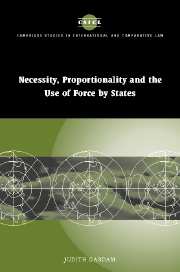Book contents
- Frontmatter
- Contents
- Foreword
- Preface
- Acknowledgments
- Table of cases
- List of abbreviations
- 1 The place of necessity and proportionality in restraints on the forceful actions of States
- 2 Necessity, proportionality and the forceful actions of States prior to the adoption of the United Nations Charter in 1945
- 3 Proportionality and combatants in modern international humanitarian law
- 4 Proportionality and civilians in modern international humanitarian law
- 5 Necessity, proportionality and the unilateral use of force in the era of the United Nations Charter
- 6 Necessity, proportionality and the United Nations system: collective actions involving the use of force
- Bibliography
- Index
- Cambridge Studies in International and Comparative Law
4 - Proportionality and civilians in modern international humanitarian law
Published online by Cambridge University Press: 16 July 2009
- Frontmatter
- Contents
- Foreword
- Preface
- Acknowledgments
- Table of cases
- List of abbreviations
- 1 The place of necessity and proportionality in restraints on the forceful actions of States
- 2 Necessity, proportionality and the forceful actions of States prior to the adoption of the United Nations Charter in 1945
- 3 Proportionality and combatants in modern international humanitarian law
- 4 Proportionality and civilians in modern international humanitarian law
- 5 Necessity, proportionality and the unilateral use of force in the era of the United Nations Charter
- 6 Necessity, proportionality and the United Nations system: collective actions involving the use of force
- Bibliography
- Index
- Cambridge Studies in International and Comparative Law
Summary
Introduction
This chapter details the content of the modern rule of proportionality in international humanitarian law (IHL) that is designed to limit the impact of armed conflict on the civilian population and civilian objects. The main focus of the analysis is the conventional and customary norm of proportionality in the context of international armed conflicts. There are increasing indications, however, that proportionality has a role to play as part of the emergent customary law regime regulating the conduct of non-international armed conflicts. Consequently, these developments are also assessed. The discussion that follows is limited to unilateral State action. The question of the application of proportionality in the context of collective enforcement actions, including peacekeeping operations, is considered in Chapter 6.
It will be recalled that, with the advent of such means of warfare as aerial bombardment, attempts had been made to develop legal protections for civilians against the impact of such practices. However, the requirement to balance the achievement of a military objective against the likely civilian losses was not established in the practice of States in the period preceding the adoption of the United Nations Charter in 1945. It was not until developments in human rights after the adoption of the Charter began to influence the law of armed conflict (as it was then known) that the movement to provide expanded protections for civilians culminated in the acceptance of the idea that even attacks on military targets must not lead to excessive collateral casualties.
- Type
- Chapter
- Information
- Necessity, Proportionality and the Use of Force by States , pp. 85 - 137Publisher: Cambridge University PressPrint publication year: 2004

